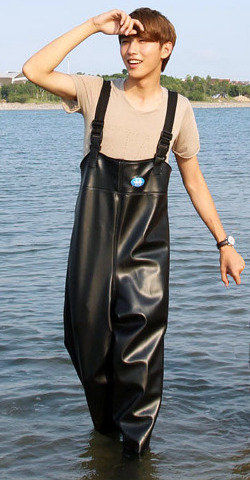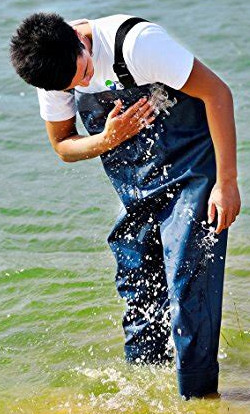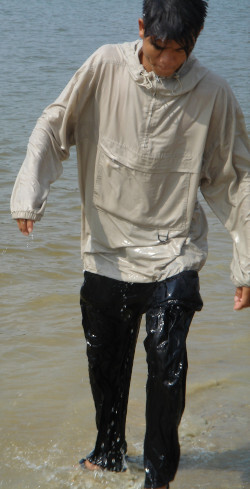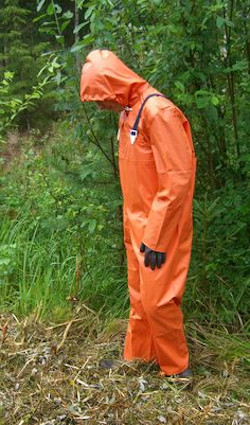Waders, Bibs, and Salopettes
Salopettes is the French word for very comfy bib-and-brace overalls. The word is used in English for similar garments worn when canoeing, kayaking, diving, dinghy sailing or just playing on the beach.
There is a wide variety of sailing bibs and foul weather gear to keep you warm in the worst weather. Keep boating all year long. They have traditionally a high waist, reaching to the chest and held up by adjustable shoulder braces without the discomfort of a belt. A secure chest pocket keeps your items in place no matter how much you’re bending and moving.
Salopettes will perform beyond expectations and last several years with careful use.
Most provide durable, waterproof and windproof protection
while offering high levels of breathability providing the ultimate protection
from both warm, wet climates and extreme wet weather conditions.
Dry Waders

Dry waders are pants with build in boots or neoprene socks,
designed to keep your clothes dry and warm when wading in shallow water.
You can wade into the water and stay dry, until you go in too deep and water pours in over the top.
Falling in or flooding your waders can be dangerous, slow you down and get heavy when you return to shore.
The best way out would be to lay down in shallow water and raise your legs to drain your waders.
Wet Waders
The clothes your wear underneath will get wet from the start but the waders don't hold water.
Wet waders are safer because you can easily swim in them.
Waders limit the water flow over your body and thus reduce heat loss.
Snug fitting thermal clothes underneath keep water warm near your skin,
while the cold flowing water passes outside your waders.

Wet Wading Pants

If you choose to not wear waders,
then wading in a quick drying anorak and pants will allow you to go into the water more often.
Feel free to spend as much time going in and out of the water in these clothes. For around $40 you’ll see that they’re well worth their price. Give them a chance and you won’t be disappointed! They’re a perfect summer outfit and won’t feel too hot no matter the temperature.
Pants or Chest Waders?
This is not just a matter of how deep you want to wade. Some people only wear thigh waders if they may need to kneel down on wet grass (e.g., on a chalk stream).
But, if it is cold or you may need to sit on anything wet, wear your chest waders, especially when wading from a boat. It is always an advantage to be able to wade deep even in a shallow river or lake. What if you suddenly had to cross the main current to follow a fish?
Sun protection is another point to consider when wading.
If you want to stay covered in the water,
a nice pair of pants, shirt and anorak will keep you comfortable for the entire day.
Inside or Outside?
A question we often get from our readers: "Should I wear my cagoule inside the pants or outside?" As always, it depends. Your top tucked inside your waders merely invites the rain to run straight in. Outside it will trail in the water.

When worn outside, a cagoule gives better rain protection, but flaps around in the wind, or floats in the water.

When the cagoule is worn inside, it stays put in wind and water, but rain runs into your clothes underneath.
Boots and Neoprene Socks
We wear boots or heavy shoes with socks for most of our wading. In easy terrain like shallow beaches we use water sandals.
For boots, remember to accommodate the extra bulk of the neoprene stocking foot in nearly all breathable dry waders. You should choose a boot at least 2 sizes bigger than your normal shoe size or one size larger than your wellies.
It is a bit of a nuisance to put on separate boots but the separate boots are so much better than the ones with the boots attached, in terms of support, comfort, protection from water pressure when wading deep and in terms of soles available. Always go for the stocking foot and separate boots.
New amphibian soles are the way forward.
They have special sticky rubber pads and ridges on the sole
that give them similar adhesion under water compared to felt.
Look out for a proper heel which stops you slipping over on wet grass or snow.
Reader Comment: Rain and Sailing Bibs
by Rene from FranceBib trousers with a sweat shirt or hoodie are my favourite watersport clothes. I have quite a few of them that I use for rain walking, sailing, and swimming. They are simpler and lighter than my sailing trousers. What I like is they don't need a tight belt like shorts, and stay in place with more freedom to move about.
You can walk in the rain so wonderfully, a bad rainy day becomes a nice rainy day in a rain bib. Furthermore, bibs can be worn for any activity that is in connection with water. You can do of course everything else you could do in dungaree jeans.
On cooler days I add a poncho or long cagoule that is no longer waterproof. It rains a lot where I live, so I go out to the lake or beach in the rain. When I reach the water I'm already very wet, so I just keep my clothes on when I go swimming.
Camping
We sometimes go on longer camping trips where we usually wear nylon rain bibs with fleece pullovers around the campsite and in the water. These clothes dry so quickly after swimming, we just keep them on all day.
Sailing
My sailing bibs are more robust trousers with reinforced panels on knees and seat. When I go sailing or canoeing I wear them with a cagoule to keep warm, because I often fall into the water. Great fun.
When we launch any boats from the beach, we carry them into waist deep water, then climb in and get going. It is so nice to be able to go in and out of the water and keep warm when boating or playing on the beach. My friends also enjoy bibs and hoodies for all kinds of water play.
Swimming
For swimming or rain walking I wear my thin nylon bibs over a sweatshirt or hoodie.
These clothes are easy to swim in, even with thermal underwear.
They create more drag than shorts, but I'm not swimming any races.
Unlike shorts or pants with a belt, they don't trap air when I jump into the water.
No billowing.
Swimming is easy for the same reason.